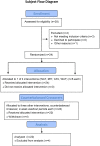Metabolic recovery from heavy exertion following banana compared to sugar beverage or water only ingestion: A randomized, crossover trial
- PMID: 29566095
- PMCID: PMC5864065
- DOI: 10.1371/journal.pone.0194843
Metabolic recovery from heavy exertion following banana compared to sugar beverage or water only ingestion: A randomized, crossover trial
Abstract
Objectives and methods: Using a randomized, crossover, counterbalanced approach, cyclists (N = 20, overnight fasted state) engaged in the four 75-km time trials (2-week washout) while ingesting two types of bananas with similar carbohydrate (CHO) but different phenolic content (Cavendish, CAV; mini-yellow, MIY, 63% higher polyphenols), a 6% sugar beverage (SUG), and water only (WAT). CHO intake was set at 0.2 g/kg every 15 minutes. Blood samples were collected pre-exercise and 0 h-, 0.75 h-,1.5 h-, 3 h-, 4.5 h-, 21 h-, 45 h-post-exercise.
Results: Each of the CHO trials (CAV, MIY, SUG) compared to water was associated with higher post-exercise plasma glucose and fructose, and lower leukocyte counts, plasma 9+13 HODES, and IL-6, IL-10, and IL-1ra. OPLS-DA analysis showed that metabolic perturbation (N = 1,605 metabolites) for WAT (86.8±4.0 arbitrary units) was significantly greater and sustained than for CAV (70.4±3.9, P = 0.006), MIY (68.3±4.0, P = 0.002), and SUG (68.1±4.2, P = 0.002). VIP ranking (<3.0, N = 25 metabolites) showed that both CAV and MIY were associated with significant fold changes in metabolites including those from amino acid and xenobiotics pathways. OPLS-DA analysis of immediate post-exercise metabolite shifts showed a significant separation of CAV and MIY from both WAT and SUG (R2Y = 0.848, Q2Y = 0.409). COX-2 mRNA expression was lower in both CAV and MIY, but not SUG, versus WAT at 21-h post-exercise in THP-1 monocytes cultured in plasma samples. Analysis of immediate post-exercise samples showed a decrease in LPS-stimulated THP-1 monocyte extracellular acidification rate (ECAR) in CAV and MIY, but not SUG, compared to WAT.
Conclusions: CHO ingestion from bananas or a sugar beverage had a comparable influence in attenuating metabolic perturbation and inflammation following 75-km cycling. Ex-vivo analysis with THP-1 monocytes supported a decrease in COX-2 mRNA expression and reduced reliance on glycolysis for ATP production following ingestion of bananas but not sugar water when compared to water alone.
Trial registration: ClinicalTrials.gov, U.S. National Institutes of Health, identifier: NCT02994628.
Conflict of interest statement
Figures










References
-
- Pereira A, Maraschin M. Banana (Musa spp) from peel to pulp: ethnopharmacology, source of bioactive compounds and its relevance for human health. J Ethnopharmacol. 2015;160:149–63. doi: 10.1016/j.jep.2014.11.008 - DOI - PubMed
-
- Singh B, Singh JP, Kaur A, Singh N. Bioactive compounds in banana and their associated health benefits—A review. Food Chem. 2016;206:1–11. doi: 10.1016/j.foodchem.2016.03.033 - DOI - PubMed
-
- Passo Tsamo CV, Herent MF, Tomekpe K, Happi Emaga T, Quetin-Leclercq J, Rogez H, et al. Phenolic profiling in the pulp and peel of nine plantain cultivars (Musa sp.). Food Chem. 2015;167:197–204. doi: 10.1016/j.foodchem.2014.06.095 - DOI - PubMed
-
- Kanazawa K, Sakakibara H. High content of dopamine, a strong antioxidant, in Cavendish banana. J Agric Food Chem. 2000;48(3):844–8. - PubMed
-
- Tohmola N, Johansson A, Sane T, Renkonen R, Hämäläinen E, Itkonen O. Transient elevation of serum 5-HIAA by dietary serotonin and distribution of 5-HIAA in serum protein fractions. Ann Clin Biochem. 2015;52(Pt 4):428–33. doi: 10.1177/0004563214554842 - DOI - PubMed
Publication types
MeSH terms
Substances
Associated data
LinkOut - more resources
Medical
